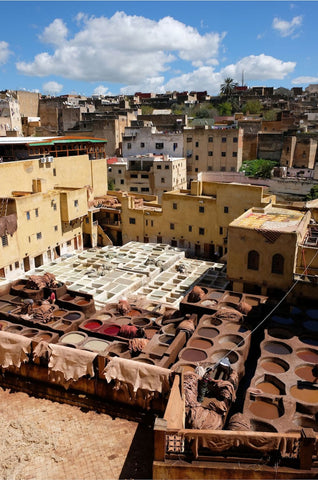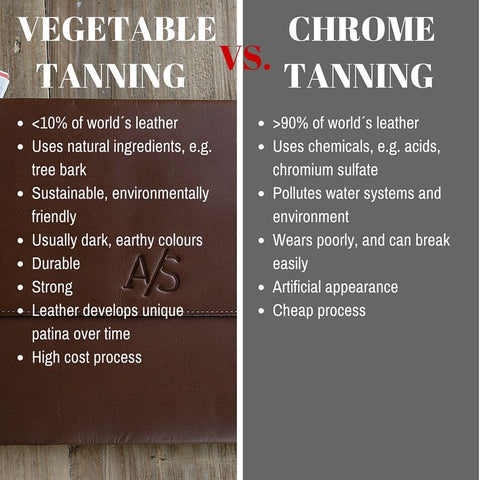What exactly is tanning?
First and foremost, let us discuss leather tanning, which is the process of converting animal skins into actual leather. The process of converting an animal’s skin into leather is primarily accomplished by removing water molecules from the skin’s collagen (which is the protein that the skin consists of). However, drawing out the skin may cause it to become dry and inflexible.
As a result, people have been soaking the skins in natural tannins since ancient times (literally for thousands of years) to dehydrate the leather, which replaces the water molecules and binds with the collagen, preventing the part where the leather from becomes stiff and inflexible!
These vegetable tannin solutions are composed of organic substances found in trees (such as oak, chestnut, or mimosa), as well as a variety of other trees and plants.
Vegetable-tanned leather takes up to two months to develop in a mostly manual process. It takes skill, patience, and care, and unlike chrome-tanned leather, the tanning process uses no harmful chemicals.
This vegetable tanning process, which involves repeatedly soaking skins in natural tanning solutions, is painstakingly slow and complex, taking at least one to two months to complete and necessitating the supervision of skilled craftsmen. This was not preferred by the forces industry, which devised a new method in 1858 for tanning leather much faster (in one day, in fact) and cheaper using a combination of chemicals, primarily chromium. Since then, chemical tanning has been the preferred method of leather tanning, accounting for more than 90% of the world’s leather.
What is chrome tanned leather?

Chrome tanning is the younger, faster cousin of veg tanning, replacing all organic tannins with a man-made compound called chromium III sulphites. It was invented in the mid-nineteenth century, and today, as mentioned earlier at least 90% of the world’s leather is chrome tanned.
Chrome tanned leather is a modern method of producing leather that is faster and less expensive by utilizing chromium III.
The chemistry of chrome tanning is somewhat complicated, but the short version is that Chrome III is good and Chrome VI is bad.
Chrome III, also known as Chromium III, is a necessary nutrient. It is available as a nutritional supplement.
Chromium VI is hazardous and is produced when companies cut costs, resulting in the conversion of Chromium III to Chromium VI.
Chrome tanned leather is produced using chromium and other harsh chemicals. It is completed in a matter of days, which is why their products are always inexpensive.
Why you shouldn’t buy chrome tanned leather products.
Environmental Impact
Leather processing is a complex process that includes tanning, dyeing, finishing, and other steps. All of these steps involve a slew of chemicals, the majority of which are hazardous to the environment. Consider polymers, resins, and dyes being released into the environment in the name of a gleaming couch.
Most of the leather produced in the United States is chrome-tanned; the EPA considers all wastes containing chromium to be hazardous. And can you imagine the health consequences for leatherworkers? Yikes!
Leather production harms deforestation, biodiversity loss, and greenhouse gas emissions. It takes a lot of energy and water to produce, and there are a lot of chemicals used in the tanning process. Many people argue that leather is biodegradable and thus better for the environment, but this is entirely dependent on the tanning process, which renders much leather today unable to degrade.
During the industrial revolution, chrome tanning was developed as a faster and less expensive alternative to vegetable tanning. Chrome tanning is a global environmental disaster that jeopardizes the health of millions of leatherworkers and everyday citizens.
The chrome tanned leather industry has pushed the environmental and human health risks of chrome tanning out of sight and out of consumers’ minds. The majority of chrome tanneries are located in developing countries such as Bangladesh, India, and China, which have lax environmental regulations and worker safety protocols.
-
Leather workers
Leatherworkers suffer greatly because of the widespread disregard for their well-being. Many leatherworkers express the belief that there are no other options for earning a living for their families. The only option is to bear the brunt of chromium and other toxic chemical exposure, despite the suffering they will endure for a couple of dollars per day. In India, a leatherworker with permanently scarred arms from chemical exposure continues to work in the tannery despite the pain, recalling, “I have worked no more than ten days per month. The itching worsens as I work more. It’s intolerable. But I have to work so that my family can survive.”
To protect themselves from exposure, leatherworkers must wear protective equipment such as masks, boots, and gloves. However, most leatherworkers in tanneries “stand barefooted in litres of sulphuric acid and chrome-heavy wastewater.” There are no masks to protect them from the fine chrome dust.” Other health risks that leatherworkers face as a result of their work in tanneries include cancer, bronchitis, pneumonia, vision problems, and even permanent blindness.
-
Gets worse with age
Another issue is that chrome-tanned products do not last long, gradually losing their lustre over time and exposure to the elements. This leather cannot be tooled after tanning due to its nature. As a result, it is unsuitable for patterning and stamping.
While chrome-tanned leather will deteriorate with time and use, it is an excellent choice for price-conscious buyers seeking supple, flexible leather in a variety of colours. Vegetable-tanned leather, on the other hand, lasts longer, develops a beautiful patina that ages gracefully, and adds a touch of elegance to your leather product if you’re willing to pay a little more.
-
Bad for Health
Now that we’ve covered some of the toxins used in the manufacturing of leather for furniture and other goods, we can consider the health impact of leather home goods sitting in your home. These items are with you at all times in your home. If it’s couched, you’re constantly sitting on them, exposing your skin to this material made from animal skin and then processed with countless earth-harming chemicals until it’s soft and supple to the touch. This texture comes at a cost: your health.
The main raw material used in the Chrome Tanning process is sodium dichromate, which is a carcinogen that damages the blood, kidneys, eyes, heart, and lungs. Sun-drying and boiling can oxidize and convert chromium 111, which is used in tanning, into the highly toxic hexavalent chromium, chromium V1.
When large amounts of chromium enter the water system, it can cause respiratory problems, infertility, and birth defects. The use of chromium also endangers workers during the tanning process. Inhaling the dust produced when chrome-tanned leather is buffed or ground up can cause respiratory problems and increase the risk of lung cancer. When chromium comes into contact with the skin, it causes dryness, cracking, and sores, which are referred to as “chrome holes.”
Child Labour
According to a study, children as young as seven years old are working with hazardous chemicals, heavy machinery, or carrying heavy loads, endangering their health and lives in Bangladesh’s lucrative leather industry. Two tannery workers, ages 16 and 17, were severely burned when the barrel of hydrochloric acid they were transporting from the shop to the tannery ruptured.
Not Durable Enough
In the never-ending quest to reduce production costs, most companies sacrifice quality in terms of leather quality and leather product production when mass producing chrome tanned leather products, which greatly reduces the lifespan of a chrome tanned leather product.
Not only is the leather-bound to fall apart much sooner than any vegetable-tanned leather counterpart; cost-cutting production methods for chrome tanned leather products include treating the edges of bags with an acrylic varnish, which causes the material to crack within a few years, rather than using techniques like turned edges or burnishing (which are more time-consuming, but create a product that lasts for decades), further reducing its lifespan.
7. Cracks Easily
Many brands have compromised their integrity by pursuing volume and profits at the expense of quality, all while causing significant environmental harm, prompting some experts to call for a ban on chrome tanning in the fashion industry.
The chrome tanning process is quick because the chemicals used dissolve parts of the hide, making the final product thinner. It also means that leather cracking and wear can occur more quickly than in veg-tanned leather, reducing its lifespan.

What is vegetable tanning?
Vegetable-tanned leather is a type of leather tanned from vegetable oil. Specifically, vegetable-tanned leather is made with vegetable tannins. It isn’t exposed to chromium salts or chromium sulphate. Vegetable tanning, as the name implies, is made entirely of natural vegetable oil.
Vegetable-tanned leather existed long before chrome-tanned leather. Vegetable-tanned leather is thought to be the most aged type of leather. People have been making leather clothing and items for a long time by exposing them to vegetable oil. There are several methods for producing vegetable-tanned leather, some of which use tree rind and others plant leaves. In any case, all vegetable-tanned leather is created by exposing creature hide to regular plant oil.
Checkout: All about Vegetable Tanned Leather
Why you should always buy vegetable tanned leather products?
When compared to chrome-tanned leather, it requires less effort to produce. Chrome-tanned leather can maintain control for more than a day. As a result, the creature should be exposed to a shower of chromium salts for at least 24 hours. Vegetable-tanned leather has a shorter tanning time. Normally, it necessitates a couple of long stretches of washing in vegetable oil.
Vegetable-tanned leather is typically thicker than chrome-tanned leather, which some people prefer. It has a thicker surface due to the tanning specialist’s use of vegetable oil. If you prefer flimsy leather garments, chrome-tanned leather is the best option. Vegetable-tanned leather is best for thick leather products.
In comparison to chrome tanned leather, vegetable-tanned leather is of better quality and environment friendly. It is expensive but good quality products are worth every penny, especially leather as it is a one-time investment that lasts a lifetime.
All leather products of Junyuan Bags, are vegetable-tanned giving you the best available leather experience at an affordable price. It has a variety of leather bags for multiple usage purposes along with a variety of leather types to choose from.
FAQ’s –
How to tell chrome tanned leather?
Because of the chromium compounds imbued in the fibre matrix of the leather, it has a dampened or artificial leather scent, or a more chemical-like scent. Scratchable, with a hazy uniform appearance and fewer visible pores. All of these traits can help you tell apart chrome-tanned leather.
Is chrome tanned leather toxic?
Yes, the main raw material used in the Chrome Tanning process is sodium dichromate, which is a carcinogen that damages the blood, kidneys, eyes, heart, and lungs. Sun-drying and boiling can oxidize and convert chromium 111, which is used in tanning, into the highly toxic hexavalent chromium, chromium V1.
When large amounts of chromium enter the water system, it can cause respiratory problems, infertility, and birth defects.
Is chrome tanned leather biodegradable?
Not only is chrome tanning completely nonrecyclable and nonbiodegradable but using a heavy mineral like chromium has disastrous environmental consequences. For one thing, there is little regulation surrounding the dumping of waste minerals and materials, particularly in low-income countries.
Is saddleback leather chrome-tanned?
Yes. As opposed to vegetable tanned, saddleback leather is chrome tanned. Many prefer chrome tanned but there are various downfalls to it. Chrome tanned leather does last but many think it does not age well.
Can you dye chrome tanned leather?
Yes, but only if you use the right leather dye for leather crafters. Chromium-tanned leathers have much more uniform characteristics than vegetable-tanned leathers, as well as greater ease of penetration during the dyeing process. Most spirit-based dyes work well on chrome-tanned leather. While it reacts differently than vegetable-tanned leather, it still works perfectly.




 Mobile/What's App/Wechat
Mobile/What's App/Wechat E-Mail
E-Mail ADD
ADD




